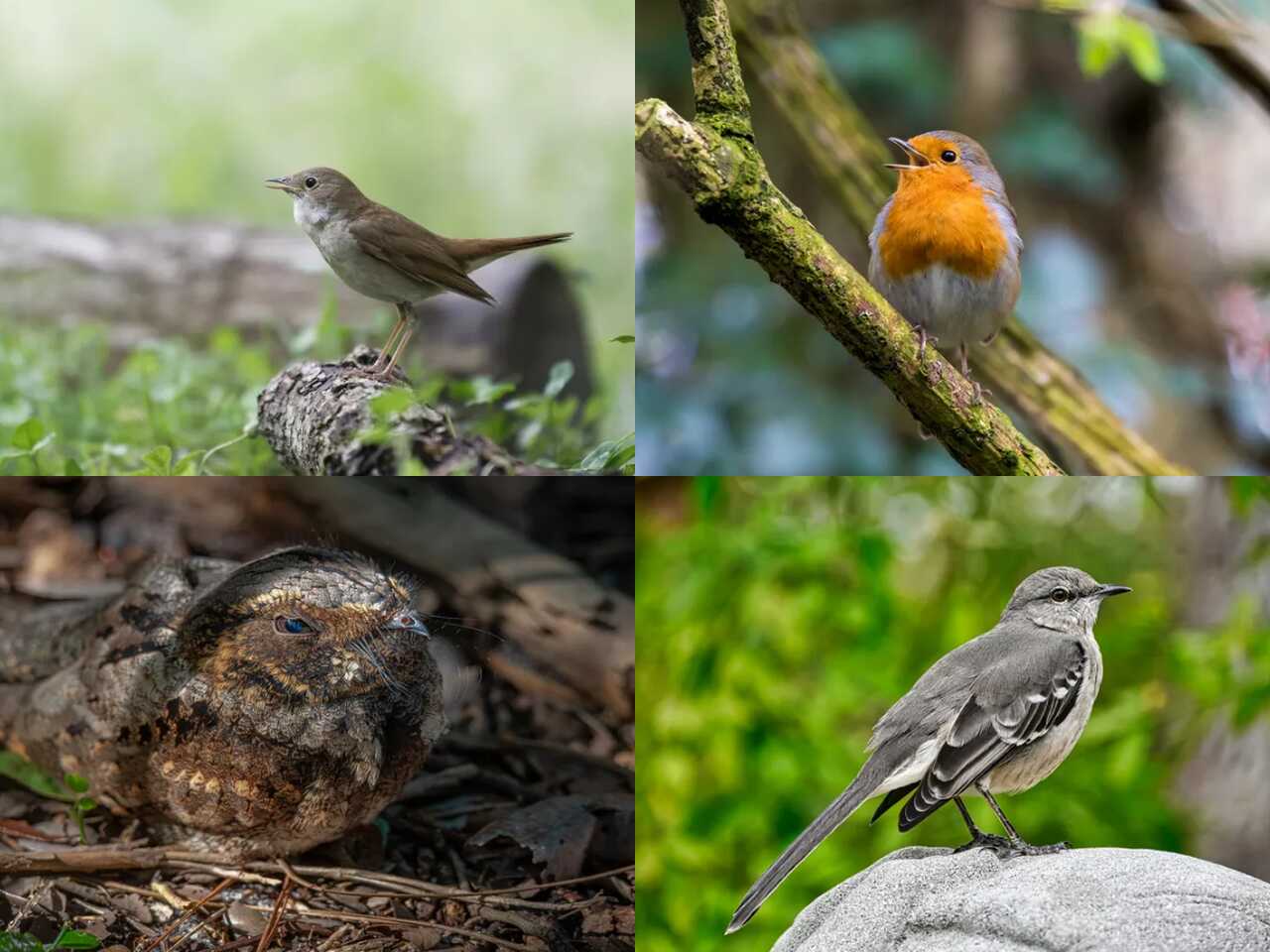Although owls are well-known for their late-night hollering, they aren’t the only creatures who sing in the moonlight. Nightingales, mockingbirds, corncrakes, potoos, and whip-poor-wills are just a few of the surprising diversity of night birds that inhabit ecosystems all over the world. Their calls can be just as eerie (or thrilling) as those of owls.
They frequently appear in nature’s dusk-to-dawn soundtrack with their after-dark arias. It is challenging to distinguish people with extensive and varied repertoires because they are seldom seen but frequently heard.
Continue reading to learn more about these birds and their lovely yet uncanny melodies so that you will be able to identify the performer the next time a concealed minstrel seduces you.
Northern Mockingbird

At night, northern mockingbirds (Mimus polyglottos‘) sound like a full-blown chorus. This medium-sized songbird normally imitates fellow birds—jays, orioles, hawks—but sometimes even echoes frogs’ croaks, creaky doors, and car alarms.
Mockingbirds can learn 200 songs their lives. Both sexes sing, but males are often more conspicuous and will arrange their songs into seasonal set lists for fall or spring. While they aren’t exactly nocturnal, unpaired males may sing 24 hours a day in the breeding season—spring to early summer—especially during a full moon.
Unlike many night singers, northern mockingbirds are not shy and will perch out in the open. They’re easy to identify by their long tails and white wing patches.
Common Nightingale

Songs of nightingales (Luscinia megarhynchos) resemble flute melodies and are composed of powerful ballads and rich notes. The species breeds in North Africa, Europe, the Middle East, and Central Asia between April and July before migrating to tropical regions of Africa for the winter.
Being notoriously timid, common nightingales frequently sing from the protection of thickets or bushes. Only men sing, and they do it in excess of 200 times in an effort to attract a partner.
In Britain, common nightingales were once widespread, but between 1995 and 2008, their populations decreased by 53%, primarily due to habitat degradation.1 However, they remain numerous elsewhere, with up to 31 million individuals in Europe and 81 million throughout the Old World.
Eastern Whip-Poor-Will

It should come as no surprise that the eastern whip-poor-will (Antrostomus vociferus), whose soulful melody may be heard wafting across a forest, is frequently portrayed as the symbol of summer nights in literature, film, and music.
Whippoorwills breed in deciduous or mixed woodlands all over the Eastern U.S. and Southern Canada in the spring and summer. They sneakily snooze on the ground during the day, where their feathers mix in with leaf litter, and then emerge to hunt insects at dusk and on moonlit nights. The term is a loose onomatopoeia for the call, which males in breeding season occasionally repeat for hours.
According to the Audubon Society, “a patient observer once counted 1,088 whip-poor-wills given rapidly without a break,” which is why “the song may seem to go on forever.”
Great Potoo

The nighttime silence in the tropical forests that stretch from Bolivia to southeastern Mexico is occasionally shattered by a deep, guttural groan that sounds somewhat like an irate cat. This is a great potoo’s (Nyctibius grandis) nocturnal insect-eating cry, one of seven potoo species found in the Neotropics. By day, the birds hide in trees, imitating broken branches with their amazing camouflage.
According to naturalist Steven Hilty in the book “Birds of Venezuela,” the great potoo calls out primarily on moonlit evenings, emitting a “fairly loud, gruff BUAAaa” at evenly spaced intervals. Even while this brief call isn’t technically a “song” in the traditional sense, it is a singular illustration of how strangely alluring night birds can be.
European Robin

European robins (Erithacus rubecula) have a propensity to maintain a territory and sing there all year long. Despite not being nocturnal by nature, they have adapted to twilight well, making them the earliest birds to start singing in the morning and the last to cease after dusk.
The Royal Society for the Protection of Birds states that “the robin is the most common night-time songster in Britain’s towns and gardens,” adding that insomniac robins in the U.K. are sometimes mistaken for nightingales.6 Other non-nocturnal species, such blackbirds, have also been noted to engage in similar night singing, although European robins appear to be the species most frequently seen doing it.
Conclusion
Bird songs may seem like pure joy, but they actually have a purpose—mostly mating, food seeking, or protection. Nocturnal birds sing at night simply because that is when they are awake, while diurnal birds are becoming more loud in the evening for a number of less-than-optimistic causes.




